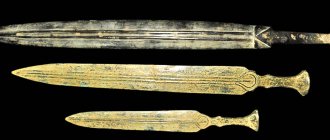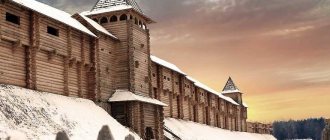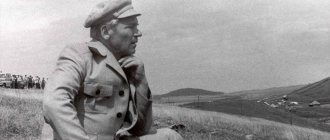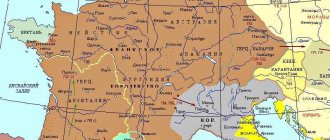From Merovingians to Carolingians
Turn of the VIII-IX centuries. In many ways, this was the time when the formation of the equestrian militia, the future of European knighthood, fell. Horsemen are by definition noble warriors. This was especially emphasized in the early Middle Ages. The Frankish power was at the forefront of the development of the military elite. Of course, first of all, technical progress played an important role: without the development of blacksmithing and the appearance of new samples of swords, helmets, shields and armor, it would be difficult to imagine medieval knights. Christian values made their own adjustments to the moral state of the riders: the former dashing liberties ceased to be held in high esteem. And the process of burying the elite has undergone changes: from the 7th century, warriors were no longer buried with harness. They were required to serve faithfully the king or counts, but thereby the nobility secured a high status for themselves, incurring certain losses in their own sovereignty.
Charlemagne. (artchive.ru)
According to the capitulary of 792, only those who had at their disposal 12 manses (a complex of residential and commercial buildings, as well as land holdings) could join the mounted militia. Such an owner could be either a poor lord or a vassal who served in the retinue of more noble and wealthy people. For service in the guard or militia, the warrior received a gift of weapons and all the necessary equipment.
Frankish cavalry. (Wikimedia Commons)
Historians often associate the appearance of a well-organized cavalry organization in the Frankish kingdom with the name of the majordomo of Austrasia, Charles Martel, who stopped the Arab invasion in 732 at the Battle of Poitiers. This theory has been subject to serious criticism more than once. But nevertheless, with the accession of the new Carolingian dynasty to the Frankish throne, the role of cavalry in public life and in war increases. This is perfectly illustrated by the Annals of the Kingdom of the Franks, as well as the works of the poet Ermold Niggel. There were more and more horses: the militia's preparations for the war were postponed to the warm season due to the need for feed for the horses.
Battle of Poitiers, 732. (Wikimedia Commons)
Roland from the Piast family. How a Polish knight became a crusader-martyr for the glory of the Church of Christ
The Polish paladin from the princely family of the Piasts, Henry, was romantically called the new Roland by his contemporaries. In 12th-century Poland, the knightly epic of the times of Charlemagne was well known. Henry was the image of a knight who fought and lived for one idea - he sought the crown of martyrdom, sought to make his way to heaven to the throne of Jesus with the sword, striking the pagans. In the 12th century, such dreams were considered noble and aroused universal admiration.
Noble Henry was the fifth son from his second marriage with the daughter of Count Berg Salome of the Polish Prince Boleslaw III, who was nicknamed Wrymouth. Henry's exact date of birth is unknown; he was most likely born between 1127 and 1131. He was named after his grandfather, Salome's father, also Henry. After his father's death in 1138, he moved to Łęčica with his mother and younger brother Casimir. According to Bolesław's statute, the young prince was to receive land in Sandomierz. The region was ruled by his mother during his minority.
The young prince was raised by German monks, who told him about the most famous knights of Europe: about the battles of King Arthur, Roland, Charlemagne and his ancestor - Prince of Poland Boleslav the Brave. Upbringing according to the code of chivalry forever formed in the young prince the desire to surpass the glory of the idol knights. Henrik purposefully prepared for a military campaign, like a true paladin.
Polish nobility in the 12th century
But his plans were disrupted by the civil war. The eldest prince from the Piast family, Vladislav, was expelled from his ancestral lands. The German king Conrad III stood up for him in the spring of 1147. The German ruler wanted to curb the Poles and subjugate them to his power. There was not enough strength to fight the Germans. It was easier for the Poles to pay off with tribute. A buyout agreement was reached. According to it, the Piast princes paid tribute to the king and promised to pay extra for “forgetting” the case of Vladislav. As a guarantee to the German court, young Henry was sent as a hostage.
It turned out that everything was going well for the young paladin. He soon joined the German knights who wanted to fight the Saracens for the Holy Sepulcher. The German king decided to go on a crusade, taking volunteer knights with him. Henry's hopes for a great adventure came true - having gathered a detachment of Polish knights, he joined the expedition. The Polish "contingent" led by Henry allied with the Czechs led by Prince Vladislav II and his brother Henry.
Armament of warriors in the 12th century (Germany)
Participants in the new campaign to the Holy Land passed through the Balkans. The crusaders then reached Constantinople. The hospitality of the Byzantine emperor Michael Komnenos lasted about two months, after which the crusaders went deep into Anatolia. King Conrad, confident of victory, hastened to attack the Saracens at the head of the German troops, leaving the Poles and Czechs far behind. On October 25, the Seljuk army attacked the Germans on the banks of the Batis River. The German army, exhausted by the heat and intense march, fled from the enemies. Until Polish-Czech help arrived, Conrad's forces were defeated by the Muslims. At night, the surviving soldiers from Conrad's army hastily evacuated to Nicaea. Seeing the failure of the German expedition, Henry, along with the Czechs, joined the French expedition led by King Louis VII. In Constantinople, he recognized himself as a vassal of the Byzantine emperor. The crusaders, eager for revenge on the Saracens for their previous defeat, again moved deep into Asia Minor. Miscalculations in supplies, the unknown route, and lack of drinking water led to high mortality among soldiers. Despite all the efforts of King Louis, the crusaders began to leave the army. Polish-Czech troops broke through to the Krak des Chevaliers castle in the county of Tripoli. Then the Czechs and Poles decided to return home. In the spring of 1148 they went to Acre, and from there they sailed by sea to Constantinople. From the capital of the Greeks they headed to Poland.
Returning to Sandomierz, Henry devoted some time to deeds pleasing to God. Founded a monastery. And then in 1149 he decided to help the Russian prince Izyaslav recapture the throne in Kyiv. This military expedition did not bring him much glory, but he returned to Sandomierz alive. Accustomed to campaigns, constant risk, and tension, the Polish knight could not sit in the family nest for a long time. He eagerly followed news from the Levant. Meanwhile, things were getting worse for the crusaders in Palestine. They asked for help in defending the Holy Land.
Prussian pagan warriors in the 12th century - enemies of Prince Henry and his brothers
In the early spring of 1153, Henry hastily collected the money needed for the expedition (he even leased the Sandomierz estates to Boleslav), and, following the beaten path through Hungary and Bulgaria, reached Constantinople. Mindful of the hardships of marching in the arid climate of Anatolia, he decided to continue by sea. "When he arrived safely in the Holy Land and honored the Holy Sepulchre, he joined the army of King Baldwin of Jerusalem." Henry's army took part in the successful siege of the Ascalon fortress, located on the shores of the Mediterranean Sea. A year later, Henryk, having lost some of his soldiers, decided to retreat to Poland. He was surrounded with adoration in the country. Songs and legends were written about the exploits of the Polish knight.
He did not participate in princely feuds. I prayed and thought about the eternal, about God. Henry distributed a lot of gold and silver to the poor, the monks. He built Roman collegiate churches in Opatow and Wislica. During his pilgrimage to Jerusalem, he met with the brothers of the Order of the Knights Hospitaller. The prince liked their ideals so much that he decided to invite the brothers to his home in Poland. Around 1163, he transferred to the Hospitallers in the village of Zagost on Nida many lands, property, a hospital and a church and granted them a number of privileges. This is how the first residence of the Knights Hospitaller appeared in Poland.
From 1164, Henry turned his sword against the pagan Prussians. They raided the lands of Polish princes in Mazovia. Having crossed the Polish-Prussian border on the Ossi River, Henry's troops attacked the Prussians in three columns. The first was commanded by Henry himself, the second by Prince Mieszko, and the third by Boleslav. The Prussians went deeper into the forests. The Poles burned pagan villages to the ground. In the end, the Prussian leaders were forced to agree to be baptized and abandon raids on the Polish regions. It seemed that the pagans were pacified and introduced to the true teachings of Christ.
But the naive Polish princes were mistaken. The Prussians were not going to keep their word. They killed the monks, tore up the letters, and resumed their old ways. The bold actions of the pagans forced the princes to move north again. In 1166, a new Piast crusade began. Decisive princes, this time used not only swords, but also gold. They bribed some of the Prussian leaders to serve as guides. But the Prussians were too cunning.
On October 18, 1166, the advanced part of the army, led by Henryk, moved along a narrow road through the swamps. Suddenly, from behind the forest, the Polish warriors were attacked by Prussian pagans. With wild screams, they pelted the Polish army with clouds of arrows, spears and stones. Then they rushed into hand-to-hand combat. Many Polish knights drowned in the swampy mire. Henry and his most loyal friends fought to the last. But Polish Roland was not destined to survive in the Prussian thickets.
The body of Henryk of Sandomierz was nevertheless carried out of the forests by loyal soldiers. He was buried in the Romanesque collegiate church in Wiszlice, which he founded for the glory of heaven during his lifetime. The body was placed in a stone tomb, which was covered with a carved slab. Prince Henry from the Piast family became the first Polish warrior-martyr in the name of Christ. He died like the legendary Roland, calling on his warriors to fight the infidels to the end.
Carolingian cavalry: weapons
How have historians formed the image of a Frankish mounted warrior during the reign of Charlemagne? Mainly by studying book miniatures of the 9th century. We can see the most famous images of Carolingian horsemen on the pages of the Golden Psalter from the monastery of St. Gallen.
Miniature from the Golden Psalter. (Wikimedia Commons)
The presence of stirrups is immediately noticeable: thanks to contacts with steppe peoples, Europeans began to actively use them in the 7th century.
The spear was mainly used for stabbing, but it was also thrown at the enemy. The round and convex shield, which was covered with leather on both sides, protected both the infantryman and the mounted warrior relatively well from throwing weapons.
The equipment of Frankish warriors was differentiated. It is associated with the social and property status of a particular representative of the military elite. The helmet was not particularly modernized, it was rather strengthened. Chain mail was worn by less wealthy warriors. Riders often included their equipment in their wills. Richer vassals wore armor: a leather suit trimmed with iron plaques. Gradually scaled armor became widespread.
For the “ancestors” of chivalry, there were only two types of swords: short (from 65 to 80 cm, light, with one blade) and long (from 90 to 100 cm, with two blades). The short one was used more often for combat, because it was more ergonomic. The long sword was used if it was necessary to finish off the enemy. Improvements in weapon manufacturing technology and progress in blacksmithing have yielded tangible results: long swords have become stronger, more convenient and of better quality.
Frankish horsemen and Vikings. (Wikimedia Commons)
But the cost of a full set of weapons and equipment for an equestrian warrior in the empire of Charlemagne forced them to regularly serve their masters - it was they who ensured the stable financial position of the lower nobility. It is also important to note that military oaths were introduced into military units by the emperor himself (for example, in 789 and 802).
Son and heir of Philip the Good
Karl inherited a very good heredity. His father Philip the Good, despite the fact that he spoiled his reputation by betraying Joan of Arc to the English, managed to give Burgundy power, thanks to which it acquired high authority in Europe. The development of art was encouraged at the ducal court, and the ruler himself was an ardent supporter of the code of chivalry and the founder of the Order of the Golden Fleece, which has survived to this day.
Philip's favorite pastimes were knightly tournaments and minnesinger competitions. It is quite clear that he tried to instill in the heir who was born on November 10, 1433, who was named Charles, the traits inherent in a real knight. Philip's labors were not in vain, and his son completely inherited his love for duels, hunting and military campaigns.
Cavalry in the campaigns of Charlemagne
Anyone familiar with the name of Charlemagne knows that his foreign policy was too active. He actually never left his horse: hiking took a lot of his time and energy. By definition, his kingdom, and later the “revived” empire, remained deeply Germanic. Wars and disputes between lords and vassals simply could not be avoided: although the church forbade Christians to kill each other, this did not stop the nobility. The issue was resolved by itself: the conflict with the Lombards, Saxons, Moors in Spain and even short-term meetings with the Normans provided an opportunity, so to speak, to throw out the accumulated negativity of Charlemagne’s cavalry army.
Battle with the Moors. (amazonaws.com)
There was also a place for the epic - famous works of medieval literature are associated with Charles’s campaigns. The Song of Roland and the Song of William recount the exploits of the Frankish aristocracy who distinguished themselves during Charles's expansion.
Charlemagne mourns Roland. (amazonaws.com)
The Carolingian cavalry is one of the well-known transitional stages in the formation of classical medieval knighthood of the 12th century. It still very clearly traces the German traditions and value system, but there is already an evolution in attitude towards service, war and property.
The youth of the future Duke of Burgundy
Guided by political considerations, the father hastened to betroth his son to Catherine, the daughter of the French king Charles VII, and so that someone would not intercept the vacant bride, he did this when the heir was barely five years old. By the way, the happy chosen one was only four years older than her fiancé. Subsequently, Charles was married twice more - to the Frenchwoman Isabella de Bourbon and the Englishwoman Margaret of York. Both of them were of royal blood.
In his early youth, Charles the Bold met and even became friends with his future sworn enemy, the heir to the French throne, Louis, when he was hiding from the wrath of his father in the Duchy of Burgundy. Almost the same age, they were strikingly different from each other. Karl the Bold - “the last knight” - was a tall and strong young man, ready to prove that he was right with a sword in his hands. Louis, short and thin, despite his small stature, was distinguished by cunning and cunning.
The beginning of bloodshed
Charles the Bold won his first brilliant victory in 1465, completely defeating the army of his former friend at the Battle of Montlhéry. This forced the king to abandon his claims to the disputed county of Charolais. Encouraged by success, the Duke rushed to new exploits. He recalled that a couple of years ago, in the city of Liege under his control, there were riots caused by exorbitant taxes. But the worst thing is that a rumor was spread among the rebels that he - Charles the Bold, Duke of Burgundy - was born not at all from Philip the Good, his official father, but from a local bishop, with whom his mother Duchess Isabella retired for confession.
A true knight, and this is exactly how Karl considered himself, could not forgive the insult inflicted on a lady, especially his mother. He acted in the spirit of his time - the cruel and dark Middle Ages. Having captured Liege, whose inhabitants did not even try to resist, he destroyed them all, including women and children. Raising his head proudly, Karl left the smoking ruins of a flourishing city just yesterday. He visited several other regions of his duchy in a similar manner.
Impoverishment of the country
Under his influence, Charles the Bold attempted to annex Alsace and Lorraine to his possessions. The beginning was encouraging, but then Louis XI, through secret negotiations, managed to turn almost half of Europe against him. Hopelessly bogged down in campaigns, the Duke completely transferred the life of Burgundy to a military footing. Since the maintenance of the army completely devastated the treasury, all entertainment was canceled. Competitions between poets and musicians are a thing of the past, and crafts not related to military affairs were simply abolished. The former prosperity turned into hunger and poverty.
The tragic end of the Burgundian ruler
At the end of the same year, at the head of a newly formed army, he approached the city of Nancy. The defenders showed enviable tenacity, and the siege dragged on. Despite the fact that, due to the low temperature, many of his soldiers received frostbite and could not continue to fight, Charles refused to retreat, hoping that hunger would force the besieged to surrender. At this time, a large army consisting of Alsatians, Austrians, Germans and French came to the aid of the city.
The day of January 5, 1477 became fatal for the army of Charles the Bold. Unable to withstand the enemy who outnumbered it, it was completely destroyed. The commander himself died in battle. A few days later, his body, mutilated with wounds and stripped by looters, was found in a nearby river. His chopped up face was so unrecognizable that only his personal physician could identify the Duke by looking at his old scars.
Defeat at Grançon
The experience of history shows that no matter how great the ambitions, no ruler alone can resist a coalition of developed countries. Charles the Bold, Duke of Burgundy, was no exception. If he somehow coped with the Germans and French, then the best Swiss army at that time was too tough for him.
He suffered his first crushing defeat in 1476 at the Battle of Grançon. Shortly before this, Duke Charles the Bold captured the city, taking advantage of the betrayal of one of its defenders. With the captured garrison, he acted as he was accustomed to do - he hanged some of the soldiers and drowned others in Lake Neuchâtel.
It became completely clear to the Swiss, rushing to help, what awaited them in the event of defeat. None of them wanted to sink or hang, so, inspired, they defeated the Burgundians. Charles the Bold, the Burgundian ruler, barely escaped, abandoning to the enemy his front line at that time, artillery and a magnificent camp full of treasures looted during the campaign.
Fearless warrior and bad politician
The characterization of Karl the Bold given to him by researchers is quite contradictory. It cannot be denied that he directed all his efforts to ensure that Burgundy, subject to him, by annexing the conquered lands to it, acquired even greater greatness. However, the result of such a militaristic policy was the ruin of the duchy and general impoverishment. Raised at the court of his father Philip the Good, Charles professed the principles of knightly honor, but, in accordance with the traditions of his time, put to death innocent residents of captured cities.
The question arises: why was Charles the Bold called “the last knight”? Probably the answer lies in the fact that he was one of those who considered political games and intrigues shameful and unworthy, preferring to resolve all issues in open battle, as befits a true knight. Undoubtedly, such an approach will give nobility to any private person, but it is unacceptable for the head of state. The leadership of a country is inseparable from big politics, and in this its head must be a professional.
Another failure
However, this defeat did not diminish the commander’s agility and arrogance. The next rake that he had to step on awaited the Duke near the city of Murten. Here Karl received an even more crushing defeat from the Swiss. From documents of that era it is known that he had the opportunity, using the mediation of a third party, to make peace and, albeit rather battered, but alive, return to his native Burgundy. However, enraged by military failures, he missed this saving chance and thereby signed his own death warrant. The fact is that the grandiose goals of Charles the Bold were incomparable with the potential that he possessed.











